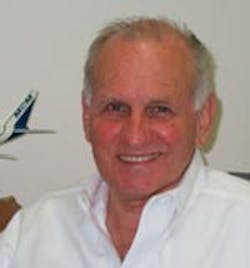Patrick O'Brien: Answering the Call
Q:Where did you start in this industry?
A: I have been in the aviation ground equipment business for over 40 years. Little did I know when I learned 400Hz as a NIKE missile technician in the US Army that it would become the hallmark of my professional career. After the Army and acquiring my engineering degree, I went to work for Hobart in the late 1960s as the Chief Engineer for ground support equipment. This is where I was first exposed to the aviation industry. My primary task was to streamline and standardize the manufacturing of all Hobart's GSE. Many of your "more experienced" readers probably still remember some of my early work with 60G20P and 90G20P diesel GPUs and later with the development of centralized 400Hz systems. I helped to develop the 575V distribution system, vertical motor generators and the method of automatic paralleling for MGs. In fact, the very first product I designed at Hobart, a 28VDC T/R, is still basically the same unit in use today. I spent 12 years with Hobart learning manufacturing and how the value of good engineering practices and quality workmanship ultimately produce the best equipment.
Q:What was your career path after Hobart?
A:After Hobart I became general manager for Devtec (now TLD-America), a Hobart distributor, for the next four years. While I supported system development at Hobart, at Devtec I learned the ins and outs of system integration and acquired a fine appreciation for the international market. I traveled to Devtec?s Hong Kong and Paris offices helping the company reorganize and expand. My close association with Hobart also led to my next move to San Francisco and the Chief Engineer?s position for McCormick-Morgan. I broadened my experience by taking charge of the early centralized pre-conditioned air designs and installations. McCormick-Morgan installed hundreds of gates of central 400Hz and pre-conditioned air for Delta Air Lines, American Airlines, Eastern and USAir among others. During my years at McCormick-Morgan I was part of the early development of the solid state frequency converter and designed the six-around-one single-jacketed aircraft cable that has become the industry standard due to its superior performance characteristics.
Q:What are you currently doing?
A:In 1991, I started MCM by taking over the 400Hz projects and assets from McCormick-Morgan. MCM steadily grew into a leading 400Hz equipment supplier and system integrator. Rather than simply broker equipment for other manufacturers I started the MCM brand of equipment that covers every component of a central or point-of-use 400Hz installation. In 1992, I started working with Boeing on improving 400Hz power in its Seattle facilities. I am so proud that Boeing and MCM still maintain a strong relationship. In fact, to the best of my knowledge, every Boeing commercial aircraft in the Seattle facilities is built or tested on our equipment. I continue to run the day-to-day operations and look for new opportunities to improve the quality of the 400Hz industry. I still love to travel and try to fit in at least one around-the-world trip per year to visit customers and promote our products.
Q:How has the industry changed?
A:Probably the biggest change has been in the way airlines and airports look at ground support equipment. This has been an interesting and often frustrating process. The airlines used to maintain a large staff of engineers and technicians that knew GSE well. They cared about the quality of the product, the performance and the overall value. The airlines controlled virtually everything from the concourse wall out. Then, as the airlines looked to reduce costs, they downsized and ultimately eliminated these valuable departments. The increasingly competitive commercial aviation market resulted in 400Hz and PCA being determined solely by low cost often overlooking life-cycle costs or long-term solutions. Virtually every customer went to whatever the "newest" technology was and marketing beat out good engineering decisions to the detriment of the industry. We are now seeing many of the airport authorities picking up the ground service equipment as part of the utilities being leased to the airline. This more recent development completes a cycle that started with 400Hz and PCA equipment being a long-term airline concern, moving to a low-cost, short-term approach by both the airlines and authorities and now back to a long-term airport authority issue.
Another very encouraging change has been the emphasis on controlling pollution at the airports. I have always promoted the benefits of turning off the APU to use ground power and we can all benefit from a greener approach.
Q:What accomplishments are you most proud of?
A:As the company owner, I am proud of my employees and our ability to design systems that satisfy the true needs of our customers. What I like to do the best is solve problems. Many times MCM loses the initial project to a lower bidder, but often we are called in after the fact to figure out why the system isn?t working properly and to make corrections. The fact that so many people call MCM for answers really makes me feel that maybe Paddy is right after all. I am also very proud that we don?t get calls saying our equipment is down or the system isn?t working. MCM has 400Hz systems that have been operating for well over ten years without a single minute of down time.
Q:When do you plan to retire?
A:Frankly, I am still having too much fun doing what I do. Solving problems and telling stories about all the GSE people I have worked with. I still love to create new products, visit new cities and meet people. I?ll retire after I?ve solved everyone?s 400Hz problems.
Q:Any parting thoughts?
A:Just one to remember ... "The sweetness of low price is soon forgotten by the bitterness of poor quality."
